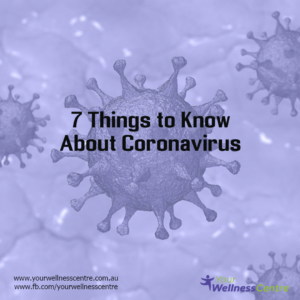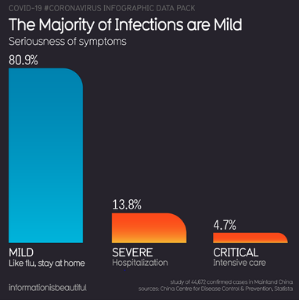With growing concerns surrounding COVID-19, it is important to remain informed of the facts regarding this viral outbreak. Let’s take a deeper look at 7 things to know about coronavirus and exactly how you can protect yourself, your loved ones and those most at risk.

1. What is coronavirus?
Coronaviruses are a large family of viruses, seven of which are currently known to infect humans. Four of these strains cause minor symptoms similar to the common cold and two are more severe diseases including Severe Acute Respiratory Syndrome (SARS) and Middle East Respiratory Syndrome (MERS). COVID-19 is the latest strain to have been identified within this family of viruses.
2. What is novel coronavirus (COVID-19)?
At first, COVID-19 was known as ‘novel coronavirus’, which means a new strain of coronavirus. Once scientists discovered what this strain of coronavirus was and how to identify it in tests, they gave it the name: SARS-CoV-2.3 When someone gets sick with this virus the illness is called COVID-19. For simplicity, the virus and the disease are being referred to by the same name, COVID-19.4Novel coronavirus (COVID-19) was discovered in 2019 when an unusually high number of people in Wuhan, China, became ill with pneumonia after having an illness similar to the flu. When doctors tested them, they found these people had a type of coronavirus they hadn’t seen before.
3. Why is it spreading so quickly?
The reason COVID-19 is spreading so quickly is simply that it is a new virus the body does not recognise, and as such has little defence against. To explain this further, viruses are proposed to evolve via two mechanisms:
Antigenic drift: Occurs when small changes (or mutations) in viral genes lead to changes in the surface proteins of the virus, known as hemagglutinin (HA) and neuraminidase (NA).
Antigenic shift: Occurs when a major change in viral genes creates new HA and/or new NA proteins, resulting in a new virus subtype.
Antigenic shift is theorised to occur when a virus from an animal population gains the ability to infect humans — a proposed mechanism behind the origin of COVID-19, which has been linked to a live animal market.6As a result of this antigenic shift, the body’s immune system may not recognise the surface proteins of the evolved virus, resulting in increased susceptibility to infection. This viral evolution may account for COVID-19’s increased virulence, as this novel virus represents a newly identified pathogen with no known pre-existing immunity in humans.
4. How is it spreading?
Transmission of COVID-19 occurs when infected droplets are distributed via human-to-human contact, usually when a sick person coughs or sneezes. It may also be spread via contact with contaminated objects as human coronaviruses can remain infectious on inanimate surfaces for up to 9 days. Airborne spread has not been reported for COVID-19 and it is not believed to be a major driver of transmission.
5. What are the symptoms of coronavirus?
- Fever, cough and shortness of breath/breathing difficulties.
Affected individuals may also experience additional flu-like symptoms including:
- Headache, muscular stiffness and pain, loss of appetite, malaise/extreme generalised fatigue, chills, confusion, dizziness, rash, night sweats, and gastrointestinal upset.
6. Who is most at risk?
Individuals at highest risk for severe disease include people aged over 60 years and those with underlying medical conditions.9 Susceptible individuals include:
- The elderly
- Immunocompromised individuals
- People with serious or chronic medical conditions including heart disease, diabetes and lung disease
- People who have recently travelled to mainland China, South Korea, Iran and Italy
- Individuals in close contact with a confirmed case of coronavirus, particularly during the infectious period
7. To put this in context…
Media outlets have focused their attention on the spread of COVID-19 and associated fatalities, contributing to alarm and unrest within the Australian community. While you should remain informed on the progression of this outbreak, you should not be alarmed, as the Australian Government is adequately addressing COVID-19 via the ‘Coronavirus Emergency Response Plan’. This scheme involves preventative measures during the early stages of the outbreak, including mechanisms for early detection and effective management of cases and contacts, and has likely contributed to current low incidences of COVID-19 within Australia.
At the time of updating this 17th March, 2020, despite reports of more than 168,000 confirmed cases of COVID-19 worldwide, there have been 368 cases within Australia. Further to this, the case fatality rate is approximately 3.6% of confirmed cases reported globally, with an estimated 80% of laboratory confirmed patients experiencing only mild to moderate symptoms followed by recovery (Figure 1). Additionally, disease in children appears to be relatively rare. Approximately 2.4% of the total cases reported involved individuals aged under 19 years, with a very small proportion of those developing severe (2.5%) or critical disease (0.2%).

Figure 1: COVID-19 disease progression and severity.
Comparisons between COVID-19 and common influenza viruses also provide context regarding population impact, with influenza estimated to have affected one billion individuals and caused anywhere between 291,000 to 646,000 deaths worldwide.
How can you protect yourself from coronavirus?
As COVID-19 is a novel virus, there is no vaccine currently available. However, practising good hand and sneeze/cough hygiene provides the best defence against viral infections. These include:
- Washing your hands frequently with soap and water, before and after eating, and after going to the toilet.
- Covering your mouth and nose when coughing and sneezing, immediately disposing of tissues and using alcohol-based hand sanitiser.
- If unwell, seek immediate guidance from a medical professional. You may be advised to isolate yourself from the general population for up to 14 days to stop viral spread.
The onset and severity of infection in response to viral pathogens is greatly influenced by the virulence of the pathogen and the host’s immune defences (Figure 1). While little can be done regarding the virulence of COVID-19, improving an individual’s immune response is the most effective strategy to protect against any pathogen.

Figure 1: Factors that influence virulence of pathogens (left) offset by physiological and lifestyle components that support immune defences, dictating the body’s response to infection.
Immune-enhancing ingredients that may be of assistance:
Furthermore enhancing and supporting your immune system and vitality can help you overcome the virus should you happen to succumb.
Below are some natural immune-enhancing ingredients that can be supportive.
- Active hexose correlated compound (AHCC™)
AHCC™ is a proprietary enzyme-fermented extract of shiitake that contains a mixture of polysaccharides, amino acids, lipids, and minerals. AHCC™ has been used in over 20 human clinical trials, with results demonstrating enhanced dendritic cell populations, increased cytokine expression of CD4+ and CD8+ T lymphocytes and improved antibody synthesis in elderly patients to the influenza B virus. AHCC™ has also demonstrated efficacy for numerous viral infectious diseases including West Nile virus, influenza virus, hepatitis virus, and human papillomavirus (HPV), demonstrating activation and modulation of host immune cells such as NK (natural killer) cells, NK T cells and gamma delta T cells.
AHCC™ is currently being distributed to the medical community treating COVID-19-infected patients in the Wuhan region of China (Wuhan Zhongshan hospital and Leishenshan hospital). Although data is yet to be published on the efficacy, as evidenced by clinical trials, AHCC™ is expected to enhance immune function of these healthcare workers, facilitating the prevention and clearance of viral pathogens that they may be exposed to.
- Andrographis paniculata (andrographis)
Andrographis has extensive evidence in reducing the incidence, severity and duration of acute respiratory infections, as evidenced by positive results in a meta-analysis, which included 33 studies. In particular, andrographis has been shown to stimulate both the antigen-specific and non-specific immune response, as well as increase NK cell activity, antibody-dependent cellular cytotoxicity and antibody-dependent complement-mediated cytotoxicity, thereby supporting host immune defences.
- Zinc
Zinc is particularly critical for the intracellular signalling pathways in both innate and adaptive immunity and is essential for the development of non-specific immunity, such as neutrophils and NK cells, and stimulating the development of acquired immunity.
- Vitamin C
Vitamin C supplementation has been shown to reduce the duration and severity of colds and is increasingly efficacious when combined with zinc. Vitamin C stimulates white blood cell production and function, enhances NK cell activity and chemotaxis, supports clearance of spent neutrophils from sites of infection, increases serum levels of antibodies, and augments lymphocyte differentiation and proliferation, thereby facilitating innate and adaptive immune responses.
- Vitamin D
It is well known that vitamin D plays an important role in regulating immune function, with deficiency impacting the activity of T regulatory (Treg) cells, as well as the production of antibodies. Additionally, vitamin D enhances the adaptive immune response by increasing the differentiation of monocytes to macrophages and stimulating white blood cell proliferation, essential to the neutralisation or viral infections.
- Medicinal Mushrooms
 Japanese mushrooms, including Cordyceps sinensis (cordyceps), Trametes versicolor (coriolus), Ganoderma lucidum (reishi) and Lentinula edodes (shiitake) enhance the body’s immune response and provide antiviral actions. Specifically, these mushrooms activate the innate immune system, triggering the production of NK cells, lymphocytes, neutrophils, macrophages, and inflammatory cytokines. Cytokine synthesis prompts adaptive immune processes to take effect, through the promotion of B cells for antibody production, and stimulation of T cells, which mediate cellular and humoral immunity.
Japanese mushrooms, including Cordyceps sinensis (cordyceps), Trametes versicolor (coriolus), Ganoderma lucidum (reishi) and Lentinula edodes (shiitake) enhance the body’s immune response and provide antiviral actions. Specifically, these mushrooms activate the innate immune system, triggering the production of NK cells, lymphocytes, neutrophils, macrophages, and inflammatory cytokines. Cytokine synthesis prompts adaptive immune processes to take effect, through the promotion of B cells for antibody production, and stimulation of T cells, which mediate cellular and humoral immunity.
- Strain specific probiotics
Strain specific probiotics, with proven human health benefits, are useful to boost and regulate immunity. Studies have demonstrated Lactobacillus plantarum (HEAL9), Lactobacillus paracasei (8700:2) and Lactobacillus rhamnosus (LGG®) all have the capacity to induce interleukin-10, a key anti-inflammatory and immunoregulatory cytokine, which is expressed by Tregs and T helper 2 cells. Animal studies have shown LGG® protects against influenza by stimulating respiratory NK cell activity, and upregulating antiviral interferon gamma (IFN-γ). L. plantarum (HEAL9) and L. paracasei (8700:2) have also been shown to stimulate innate immune responses.
What to do if you develop symptoms
If you do develop symptoms associated with COVID-19, including fever, cough, sore throat, tiredness or shortness of breath, seek immediate guidance from a medical professional. You may be advised to isolate yourself from the general population to stop viral spread.
Individuals who have recently travelled to an international high-risk area or who have recently been in contact with a confirmed case are at an increased risk of developing COVID-19 and are advised to contact a medical professional for assistance.
References : Metagenics, Northgate Queensland
For further resources and guidelines on COVID-19 management:
Australian Government Department of Health: COVID-19
https://www.health.gov.au/health-topics/novel-coronavirus-2019-ncov
World Health Organisation Coronavirus Disease (COVID-19) Outbreak
https://www.who.int/emergencies/diseases/novel-coronavirus-2019
Centre for Disease Control and Prevention: Corona Disease 2019 (COVID-19)
https://www.cdc.gov/coronavirus/2019-ncov/about/

